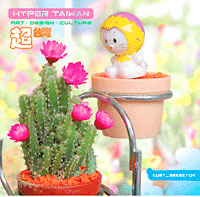Michael Farrell reviews
Hyper Taiwan: Art Design Culture
by Kurt Brereton

Published by Art & Collection Group (Taiwan)
260 pp, full colour, perfect bound
ISBN 986-7519-56-6
Distributed in Australia by Manic Exposure Tel (613+) 9384 1437
This review is 1,550 words
or about 3 printed pages long
Experimenting with Sugar
The book begins and ends with hyper-pink: a colour designed to make white people edgy…
Taiwan is hard at work on the desymbolisation process, countering empty U.S. gesture. Recontextualisation is everything: statues of liberty, Greek goddesses, start making sense again. Contra Carey’s Wrong About Japan, Brereton’s bi-lingual photo-crammed guide/ lifebook is Joyful, Joy-thoughtful About Taiwan; the digital expressed as a nice, solid paper block. Solid meaning whack-quality: you can turn the pages … which I did compulsively at first, but the pleasure is in slowly following Dr Kurt (as he is introduced by Dr Lin Pey-Chwen of National Taiwan University of Arts). ‘ “There is no such thing as rest, only motion.” ’ a Dr Kurt quote from Umberto Boccioni; old futuristic quotations are scootered in for the ride (Baudrillard recurs.) “Scooters are the first to feel … ” “All over Taiwan, day and night, time and motion patterns of complex chaotic design are being mapped out” (i.e. on scooters).

This is what urbanity’s really about: living in an environment created by the vibrations of our objects (Boccioni again). Scooter riders create bleeds of human-neon … The tribe of scooters an ever-returning re-flocking pigeon; a rhizomatic elegy. (And a reenactment: ‘Taiwan has an extremely high per capita traffic accident rate” HT 30.) Hyper Taiwan reverses Brereton’s earlier culture shock as a young traveler: by providing shocks for the Taiwanese (see intro); homeopathic doses for would-be Taiwan visitors; and by repackaging Taiwan with traces of extra-Taiwan or hyper-Brereton culture. Balancing the hyper-modern image of the scooter, Brereton chooses the image of a rat for himself as the ‘artist, academic and tourist’ poking his head out of the fridge. But someone he meets likens him to a stuffed koala on a sculptured horse.
Using Baudrillard, Brereton introduces the book’s theme or concept by discussing the hyperreal — where signs stand in for the real — and giving reality TV as an example. Yet isn’t it a bit late for such a theory — doesn’t Big Brother stand in for Friends rather than reality? There’s more to hyper though, as anyone who’s experimented with sugar on kids knows: ‘extremes’ ‘exaggeration’ ‘excitability’ ‘stimulation’ etc. If Taiwan is a sweet potato the Taiwanese are sweet potato farmers, growing a whole new tuber (or rhizome) from a colonial chip.
Brereton makes the point that ‘virtual’ is an analogue, and in a sense, colonising word, as if digital exists within analogue. He offers the following as a ‘mode … of being’: ‘Sampling… editing… burning… playing… recording… over… again’ — sounds like life, as a tv drama mother might say.

Photos: blurred pics: the hurriedness of the shot suggesting disintegration, the whirl of atoms, a dimension unseen by an eye. Brereton joins the mode of being by recording junk scenes, would-be installations (amateur and wornout versions of hyper), and reinserting them into the cycle. (A photographer friend once said to me that I’d get sick of photographing ‘leftovers’: being dependent on what I found … but when I do — sometimes everything seems like art already — I just take a break — and return to the leftovers.) ‘FUCK’ ‘BITCH’ and the love heart symbol become fresh amidst the graffiti of Chinese characters. One attempt of art is freshness — or new tiredness — but in an unfamiliar culture, such attempts might seem redundant: refreshing what is already overstimulated.
Brereton suggests that, like grand narratives, big nations don’t make much sense to Taiwan: too slow and boring anyway. Reading Hyper Taiwan, consumerism begins to seem interesting: part of the energy flow, light years from the dreary-tiredness of Peter Costello and Chadstone (or whatever megamall comes to mind). Contra the Lou Reed song, there’s no waiting for the (Ferry) Woman to get your fix of betelnut, a popular cheap stimulant available at glass booths, their frequency increasing as you leave the cbd for the margins.
Photos: red creeps in. Chairs, mops of lettuce, the performance over or about to begin.
Found images balance those of cute culture a culture of infantilisation as a radical/ reactionary/ neutral defence against/ incursion into/ out of consumerism/ authority. AstroBoy, Pokemon and Hello Kitty are famous examples. Western cuteness is no match for the armies of cute Asian robots … ‘Cute can burn holes in your comfortable ideas of beauty and coolness’. Every day in every way we’re getting flatter and flatter.
Brereton accompanies his (and others) reflections on time with a series of art works (watercolour and ink stamps on paper, found posters, a towel) that deal with slow time, that bring Taiwan’s past in Brereton’s present, that stop Taiwan time for Brereton to behold it, make it art. Clouds droop, figures speak with inkstamp bubbles.
Brereton moves from the space of time to the rhizome of toys. A Taiwanese dragon eats Bart Simpson; the next photo is of a toy I have: a boy on a bell cycle, though the arms of mine have come out of his sockets.
Two paintings: making a leap (forward in space, backward in time), a cute Chinese-speaking kangaroo with a camera converses with two English speaking colonial dolls, both dumb and knowing. The shadow of a doll on the kangaroo’s back turns her arm into a sword moving across the red landscape.
Photo: fluorescent moon with plastic palms.
Indigenous and digital — Brereton’s precis of new media development serves as an intro to and a basis for Taiwan-based works. And a digital work like the ad: “Aborigines go better with Coke”. Anthropologists reckon Taiwan to be the original home of all Polynesians. Fuelling the hyper and the cute, the seeming innocence of hypercute consumption and production, is colonialism and suppression: primarily by the Chinese, though in centuries past the Portuguese and Dutch lent a hand. To the 19 000 000 foreign visitors, the 400 000 Yuanzhumi (original inhabitants) are reduced to a sign of tourism. Predictably, the Yuanzhumi are the ones affected by nuclear waste dumps — and are the ones striving to increase ecological awareness. Brereton suggests that the digital may offer solutions for the Yuanzhumi, through global indigenous activist networks, and through rethinking code.
Brereton writes ‘the photograph is dead, long live the digital image’; ‘all images are now rightly seen as fictions’. This seems like posturing … describing his own liberation, rather than a more nuanced development or explosion even: that moves in all directions. He ignores the effects that digital culture has had/ can have on analogue photography, (as similarly, photography did on painting) and assumes a bit too much re a viewer’s assessment of any image. Photography may not be the same now/ again, any more than poetry is; new media to me means more media, not replacing media. What perhaps has changed irrevocably is the language used to talk about these things, but isn’t this (e.g. using ‘similitude’ rather than ‘representation’) as much about what feels right, the experience of saying it? Our minds are changing. That’s more interesting than the new things we think. Brereton recognises problems of language: the word ‘painting’ no longer means what it did.
The generalising becomes meaningless; by page 180 I think his argument would’ve benefited from a brief study of a how particular new media artists work (we get this at page 196). Though he refers to the pomo effect of bad painting, faux naive etc. — and there are many artists who probably wouldn’t touch a paintbrush (particularly in Taiwan?) — many other artists use contemporary technologies and paint at the same time; graffiti artists also complicate the picture). It’s rhetoric as much as art that gets tired; the split between digital and analogue can be seen as radical, yet we can read the past — modernist painting, or Egyptian cartoons, or African drumming as approaching-digital.
Just as Brereton gets boring he gets more interesting, referring to the need for a guide to negotiate the everyday; of uploading the smell of ‘stinky tofu’ to his ‘mental ‘biocomputer’’. We aren’t robots yet, just somewhere along the path.
At times Brereton’s language mimics the hyperreal, as he extends a figure out of reach of a referent or irony: or at least what irony used to be, pre-digital. Now virtual ironies proliferate, detached from authors, in pure forms that can be pumped in or deleted.
One art critic’s cool is another’s warm … digitality rethinks these basic terms. What becomes of affect? Brereton gives examples of four Taiwanese post-grad students’ work (all studying in Australia under Brereton’s supervision), suggesting the depth, the re-realisation of new digital art, gradually building a new image of ‘human’. Experiencing the digital has now become more emotional than experiencing analogue art: analogue’s pathos residing in its otherness, its pre-humanity. The analogue too, becomes more real as it becomes part of the analogue world, (as opposed to the real vs art world) and material for the digital. A post-Brechtian, post-Duchampian world, and one more Taiwanese than I knew.
Related links:
www.kurtbrerton.com
www.arttowermito.or.jp
www.taiwanfirstnations.org
www.corel.com
www.tmoa.gov.tw
www.here.com.tw/ chat
www.cybergeography.org/ atlas/ topology.html
www.juliusandfriends.com
www.angrylittlegirls.com
www.toppa.com
www.sarotech.com
www.djmonkeyboy.com
www.asahi-net.or.jp

Michael Farrell, 2006
Michael Farrell is a postgrad student at Deakin University, Melbourne, Australia.
His book is ‘ode ode’ <http://www.saltpublishing.com/books/smp/1876857536.htm>.
He distracts himself with reading events and editing projects.
it is made available here without charge for personal use only, and it may not be
stored, displayed, published, reproduced, or used for any other purpose
This material is copyright © Michael Farrell and Jacket magazine 2006
The Internet address of this page is
http://jacketmagazine.com/29/farrell-brereton.html
